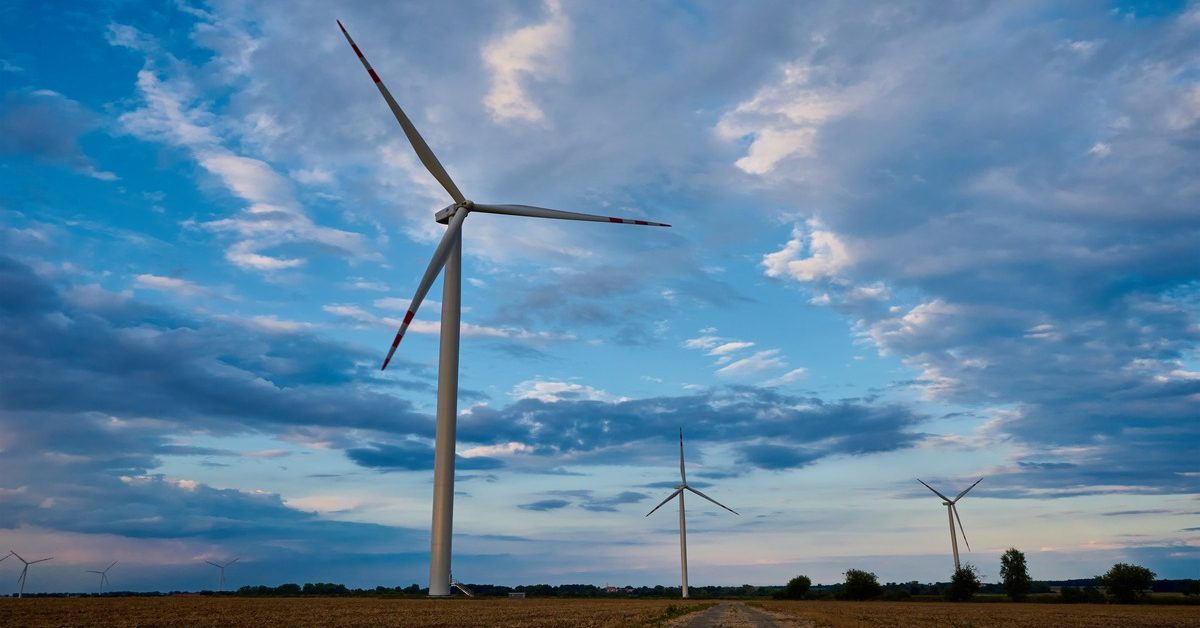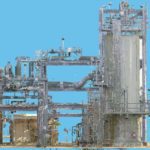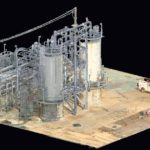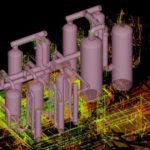According to the Center for Climate and Energy Solutions, renewable energy—such as solar, wind, and geothermal energy—is the fastest-growing energy resource in the United States. There was a 42% increase in renewable energy generation from 2010 to 2020, up 90% from 2000 to 2020.
Renewables also made up almost 20% of utility-scale electricity generation in 2020, with wind power forming 8.4% of this electricity generation. To accommodate this growing demand, new wind farms are being constructed at an accelerated pace, with $20 billion invested in this sector in 2021, according to the latest report from the Department of Energy.
The wind turbines that transform the kinetic energy of wind into electrical energy require significant preventative maintenance and damage assessment to remain in optimal condition.
While some wind farm operators rely on traditional inspection methods to perform preventative maintenance and damage assessment, newer technologies—like advanced sensors, artificial intelligence, and unmanned aerial vehicles (UAVs)—are being increasingly utilized due to their many safety, revenue, and efficiency benefits.
In this article, we’ll examine how wind turbine blades are inspected by drones, list down the most salient benefits of wind turbine drone inspections, and discuss the steps to choosing the right drone to inspect wind turbines.
How are Wind Turbine Blades Inspected by Drones?
Drones are launched into the air with the aim of collecting both visual and thermal data about the blades and other critical wind turbine components—including the main bearings, nacelle, and generators. By fusing AI with interchangeable, advanced sensors and visual or thermal cameras, drones are able to perform wind turbine blade inspections while technicians remain safe on the ground.
The resulting high-resolution images and videos from the digital or thermographic camera are relayed to the technicians at the ground control station. The UAV data is typically collected by a digital asset management system or data visualization system for further analysis. Both the interior and exterior of the blades can be inspected during wind turbine drone inspections.
Unlike traditional wind turbine inspection methods—like rope access and platforms—human personnel remain on the ground, which greatly enhances their safety. The drones also capture high-resolution images, making it easier to spot defects that would have been easily missed by technicians performing ground-based ocular inspections.
UAVs can photograph wind turbines from any angle, including those that cannot be reached by technicians. In fact, drones like the ELIOS 2 from Flyability have been known to improve the scope of internal blade inspections since they can inspect 40% more of the blade’s interior than a human inspector.
During the inspection, the drone will inspect both sides of the blade for missing bolts, cracks, lightning damage, delamination, and other defects that would compromise the blade’s functionality.
Aside from the blades, the following wind turbine components will also be inspected by the drone for signs of wear and tear:
- Tower – Signs of corrosion, peeling paint, cracks, and other damages.
- Nacelle – Signs of corrosion, lightning damage, oil splits, cracks, peeling paint, and other damages.
- Hub – Loose connections, skewness, and other damages.
Five Benefits of Wind Turbine Drone Inspections
In the absence of preventive maintenance, the cost of repairing and replacing damaged wind turbine parts could reach $30,000 per year. Drone inspections make it faster, safer, and more economical to conduct preventive maintenance on onshore and offshore power generation assets.
Listed here are the five main benefits of conducting wind turbine drone inspections:
Increases inspection frequency
While the degree of maintenance needed to keep a wind turbine operational will depend upon numerous factors, including specific operating conditions and the materials used, generally, wind turbines need to be inspected two to three times per year. These preventive maintenance inspections may need to increase as the turbine ages.
Traditional inspection methods—like rope access and platforms—are notorious for being both time-consuming and labor-intensive since they require technicians to examine the structural components very closely. Ground-based ocular inspections, meanwhile, are known to be time-consuming since cameras need to be set up to capture each side of the blade.
The inspection of a single wind turbine using traditional inspection methods could take anywhere from three to six hours, depending on the complexity of the perceived damages. This translates to a paltry one to two wind turbines per day for a team of three inspectors.
The latest generation of wind-resistant UAVs, in contrast, can complete a wind turbine inspection in as little as 45 minutes. This greatly increases inspection frequencies while reducing average inspection times.
Reduces risk
Aside from being slow and labor-intensive, the rope access and platform method also exposes technicians to safety risks since they’re required to work from great heights. Using drones to perform wind turbine inspections eliminates this safety risk as technicians won’t be required to ascend to great heights to assess structural damages.
Traditional internal blade inspections also require technicians to physically enter each wind turbine blade to assess damages. This exposes technicians to the hazards associated with confined spaces. Using drones means technicians don’t have to be directly involved in the inspection process, removing this safety risk completely.
Reduces inspection cost
As previously mentioned, the rope access and platform method requires technicians to work from great heights, which translates to higher insurance costs. Also, this inspection method requires at least three technicians to inspect one wind turbine, which translates to higher labor costs.
Drone inspections require the involvement of fewer technicians, while the operational expense of drones is significantly cheaper than traditional inspection methods. Since fewer risks are involved, insurance costs are also lower. This, in turn, further lowers average inspection costs.
Decreases turbine downtime
Unlike traditional inspection methods, drone inspections don’t require wind turbines to be shut down for prolonged periods to facilitate manual inspections. Drone inspections, including internal blade inspections, can be done more quickly compared to traditional methods.
Wind farm operators know that every second a wind turbine is non-operational means lost potential revenue. In other words, the reduced turbine downtime translates to greater profitability for wind farm operators.
Produces better data
With the help of digital or thermographic cameras, drones can capture high-resolution images and videos of areas that human inspectors can neither see nor access. Case in point: in manual internal blade inspections, inspectors are only legally allowed to reach a certain depth into the blade, leaving a significant portion of the blade uninspected.
Drone inspections allow deeper inspections into the blade, resulting in more in-depth and accurate data. The gathered data can then be analyzed by experts who’re trained to spot critical defects and signs of structural degeneration.
Drone technology can also be combined with other emerging technologies—like digital twin technology, artificial intelligence, and advanced machine learning algorithms—to further enhance wind turbine preventative maintenance and damage assessments.
Digital twins, which serve as the real-time virtual counterparts of physical objects, can be used to simulate the behavior of wind turbines under different circumstances. Performing these simulations allows analysts to diagnose the health of the generator, predict future failures, and estimate the remaining useful life of wind turbines.
The data gathered from digital twin simulations can also optimize wind turbine modeling and designs, making it a vital aspect of systems engineering.
How to Choose the Right Drone to Inspect Wind Turbines
While numerous drones from different manufacturers are available on the market, only a select few are suitable for wind turbine drone inspections. You can rule out most consumer drones since they lack the features and engineering needed to conduct wind turbine inspections safely. To ensure accurate, safe, and reliable inspections, consider opting for commercial drones from makers like DJI, Flyability, and Autel.
Unlike consumer drones, commercial drones can operate safely in high winds. Commercial drones also have reliable ground stations (i.e. remote control systems), are equipped with cameras that capture high-resolution images, and have software platforms that facilitate data collection and analysis.
Here are the additional characteristics you should look out for when choosing commercial drones for wind turbine inspections:
Strong flight capabilities and a steady hover
In windy environments, drones need to possess a steady hover to conduct seamless inspections. Drones that possess subpar flight capabilities and an unsteady hover are more likely to crash into the wind turbine or the ground, potentially damaging the wind turbine and endangering the technicians on the ground.
A viable commercial UAV should be able to find the set target, align its camera lens, and stabilize while in-flight to ensure the capture and transmission of crisp data and imagery.
A great industrial-grade UAV to consider is the DJI Matrice 300 RTK. This UAV is equipped with six-way positioning, obstacle avoidance sensors, and stellar in-flight stability. Despite its hefty price tag, it’s a worthwhile investment if you want to conduct seamless wind turbine drone inspections.
Weatherproof camera lens
Aside from high winds, drones also need to withstand other elements, like lightning, snow, hail, rain, and debris. Consider getting a commercial drone with a protective camera lens coating to safeguard the lens from abrasive elements.
A high-resolution camera
To ensure accurate status reports, your drone should be equipped with a high-resolution camera. Such cameras will ensure detailed data captures of turbine blades and other critical components, like the nacelle, rotor blades, and bolt joinings.
For first-class optics, a great commercial drone to consider is the DJI Mavic 2 Enterprise Advanced. This drone is equipped with a 1/2 inch CMOS 48 MP visual camera, as well as a 640×512 radiometric thermal sensor. The camera has 4x lossless zoom and up to 32X digital zoom, allowing you to get highly detailed image captures from a safe distance.
High-quality UAV data collection and imagery help analysts from environmental consulting agencies (like us!) make accurate structural assessments, resulting in better remedial plans.
High-definition video sensors
Drones with HD video sensors can capture additional footage, as well as provide live-stream feeds during inspections.
If you’re looking for a UAV that’s specifically designed for internal drone inspections, consider Flyability’s Elios 3. This UAV can seamlessly perform inspections in confined spaces (like the interior of wind turbine blades). It also has a dual thermal 4K camera that offers 12 megapixel HD live streaming. Other useful features include LiDAR Mapping.
Acceptable flight times
Most commercial drones can stay in the air for 20 to 30 minutes before needing a recharge. The DJI Matrice 300 RTK is a notable exception as it provides 55 minutes of flight time. This allows technicians to conduct longer and more productive aerial inspections of wind turbines.




